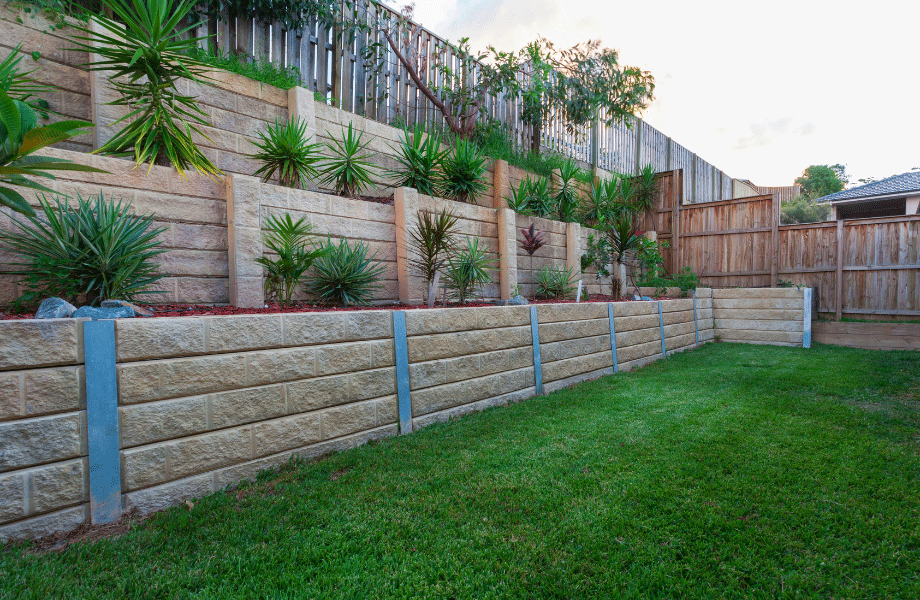
Tips on creating a multi-level garden bed
How do you want to use your multi-level garden bed
Your first question needs to be, how do you want to use your multi-level garden bed?- Do you want to create visual impact in an otherwise flat backyard?
- Are you trying to grow, access and enjoy flowers and vegetables in a backyard with a steep incline?
- Would you like to create different spaces on different levels in your outdoor area – such as for entertaining and socialising. Maybe you’d like a children’s play area, a fire-pit or a relaxed sanctuary to read and enjoy your morning coffee?
Start with a blank canvas
Ideally, you will be creating a multi-level garden bed on a blank canvas. This means removing anything and everything in the way of your base-level garden bed. Dig up old plants and create a level garden-bed area. If you’re planning on using the old plants in your new garden beds, carefully set them aside, ready for re-planting later.
Retaining walls
Use retaining walls to delineate your spaces and create multiple levels in your backyard or outdoor area. This maximises your available garden space and gives you the multiple levels you’re looking for. Retaining walls are usually made by excavating a part of a slope in your yard and using the excavated soil to backfill and create a more even, usable area. Retaining walls can be constructed from a range of materials, including concrete blocks, stone and timber. Your available space, budget and vision will all be relevant when it comes to deciding on the design, size, and materials for retaining walls.Steps, paving, decking
Steps, paved areas, decorative rocks and decking are great ways to create zones within your multi-level garden beds. You can delineate areas for entertaining, relaxing, playing, or creating amidst your garden beds. This will maximise your usable backyard space and give flexibility for enjoyment of your multi-level garden beds by all members of your family. Choose the look and function you’re after that best suit the zones you want to create.
Creating your garden beds
Once you have your levels and zones created, it’s time to create your garden beds. Lay a base layer first. This will prevent weeds, and hopefully, pests. Depending on the construction of your levels, you can use cardboard, mulch, concrete, fabric or plastic. Create your garden beds with multi-purpose garden soil, which is perfect for on-ground and raised garden beds. This high-quality screened soil will improve your existing soil structure and is a great growing medium, with high organic matter and superior drainage capability. Your plants will be well-fed and garden beds will be children and pet safe as well.Edging
Edging for your garden beds can be created by your retaining wall materials, or you can add a further design feature by incorporating new materials. Create clean lines for your multi-level garden beds with Formboss galvanised or Redcor metal edging. The effect can be modern, or charming and rustic. Or create a natural, organic look with decorative stones and pebbles. These will give the impression that your garden beds are being created straight out of the earth.
Levels on levels
To add visual impact and create a gorgeous architectural feature in your multi-level garden bed, why not add levels to your levels? The 3-Tiered Redcor Planter is a favourite way of adding personality to any outdoor space. The planter can be used to grow vegetables, herbs or flowers and could be the perfect addition to any level of your multi-level garden. Made from Redcor steel for additional protection from the weather elements, the planters are durable enough to last many years. The stunning scarlet steel will form a stable oxide layer over time, creating a patina. And why stick to three levels – in this Redcor range, there are 4-Tiered and 5-Tiered planters available, as well as individual planter rings. Give us a call if you’re interested in the 4 or 5-Tiered planters so we can order them in. Now that you’ve got fresh inspiration and a few tips for creating multi-level garden beds in your outdoor space, why not look at other DIY projects. We’ve got so many fantastic how to guides, from DIY firepits to garden ponds. Or if you have something else in mind, contact our expert team to talk through your ideas. We’d love to help! Keep your eye on our How To and Product Info pages for most posts like this one.
Now that you’ve got fresh inspiration and a few tips for creating multi-level garden beds in your outdoor space, why not look at other DIY projects. We’ve got so many fantastic how to guides, from DIY firepits to garden ponds. Or if you have something else in mind, contact our expert team to talk through your ideas. We’d love to help! Keep your eye on our How To and Product Info pages for most posts like this one.

